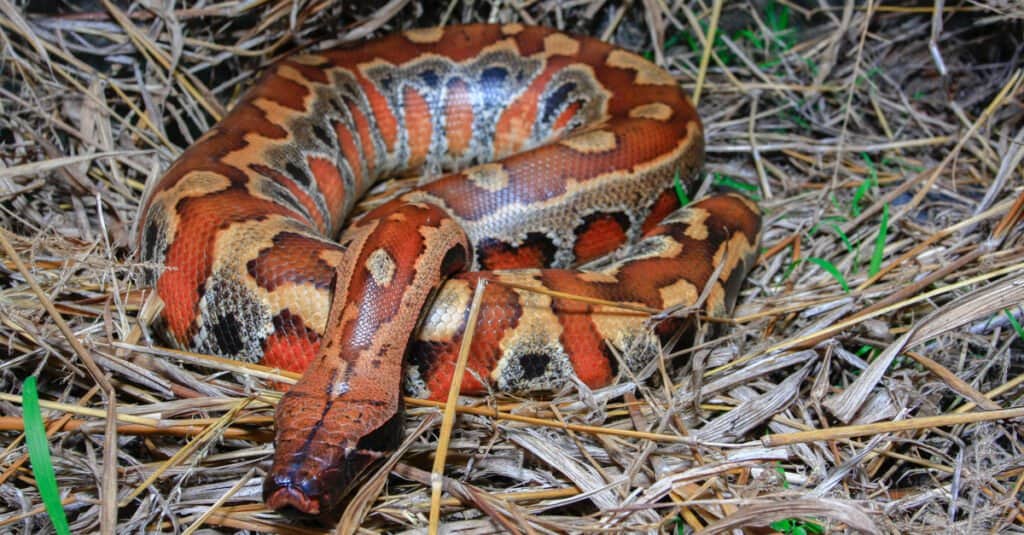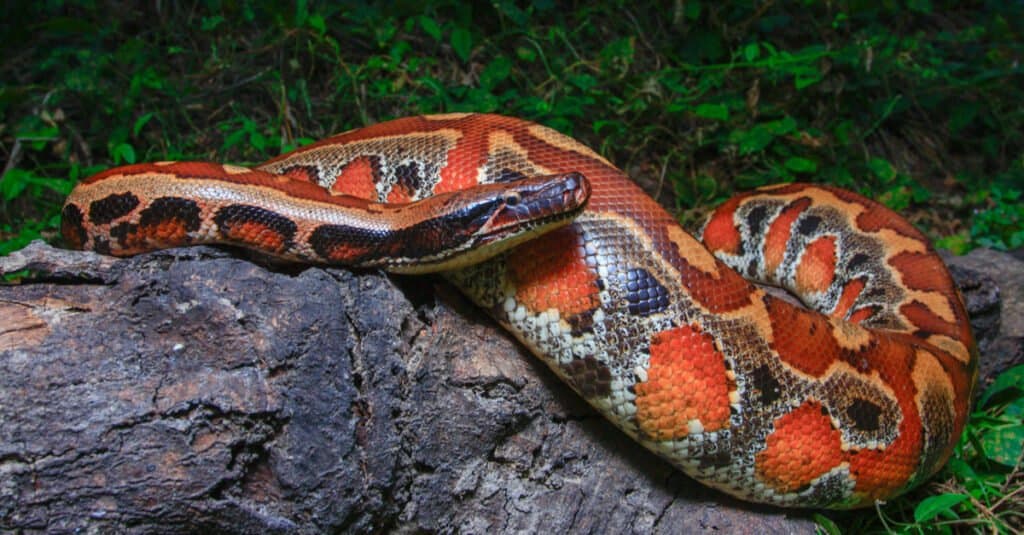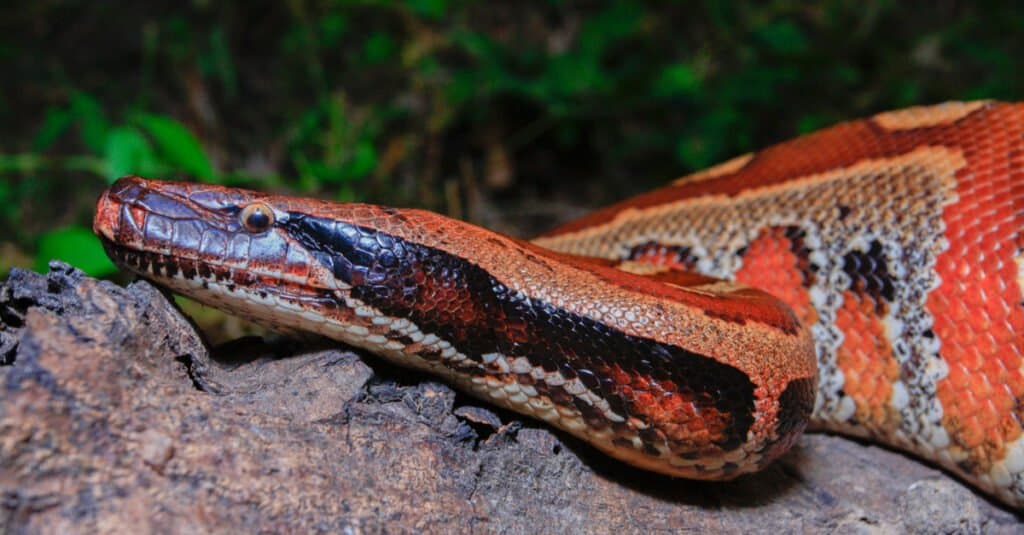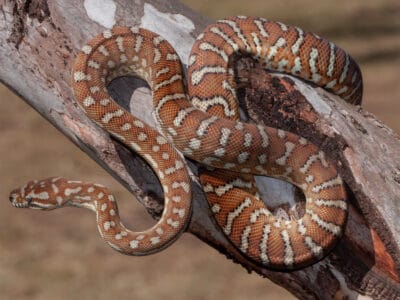Blood Python
.jumbotron {
background-image: url(“https://a-z-animals.com/media/2022/01/Blood-Python-header-400×300.jpg”);
}
}
@media only screen and (min-width: 641px) and (max-width: 920px) {
.jumbotron {
background-image: url(“https://a-z-animals.com/media/2022/01/Blood-Python-header-470×370.jpg”);
}
}
@media only screen and (min-width: 921px) {
.jumbotron {
background-image: url(“https://a-z-animals.com/media/2022/01/Blood-Python-header.jpg”);
}
}
Blood Python
Python brongersmai
Blood pythons are so called because of the blood red markings on their skin.
Blood Python Scientific Classification
- Kingdom
- Animalia
- Phylum
- Chordata
- Class
- Reptilia
- Order
- Squamata
- Family
- Pythonidae
- Genus
- Brongersmai
- Scientific Name
- Python brongersmai
Read our Complete Guide to Classification of Animals.
Blood Python Conservation Status
Blood Python Facts
- Prey
- Rats, mice, and other rodents
- Fun Fact
- Blood pythons are so called because of the blood red markings on their skin.
- Litter Size
- Between 12 and 14 eggs
This post may contain affiliate links to our partners like Chewy, Amazon, and others. Purchasing through these helps us further the A-Z Animals mission to educate about the world’s species..

Discover alligator-eating snakes, spiders larger than your phone, and 1000 more incredible animals in our daily FREE email.
.photo-gallery {
–margin: 0px auto 0px;
–padding: 0px 0px 0px 0px;
}
.gallery-link {
background-image: url(“https://a-z-animals.com/media/2022/01/Blood-python-on-rock-1024×535.jpg”);
background-repeat: no-repeat;
background-size: cover;
background-position: center;
height: 500px;
justify-content: center;
text-align: center;
align-items: center;
display: flex;
border: 2px solid #000;
}
.gallery-link img {
height: 50%;
}
@media only screen and (max-width: 768px) {
.gallery-link {
height: 300px !important;
}
}
View all of the Blood Python images!
Up and about at dusk or dawn, the blood python, also known as the red blood python, is a crepuscular animal. These are non-venomous creatures active between morning and evening hours. (The list includes bobcats, chinchillas, mice, wombats, and possums.)
5 Amazing Blood Python Facts
- Once considered aggressive and unpredictable, it came to be the behavior was the result of adult snakes caught in the wild and held in captivity.
- Breeders, herpetoculturists and snake enthusiasts love the blood python due to the snake’s relatively small size and its striking color and pattern morphs.
- The specific species name, brongersmai, comes from Dutch herpetologist Leo Brongersma.
- Today, the blood python thrives in protected habitats and human-modified habitats.
- There’s a tube at the bottom of the snake’s mouth that allows the blood python to breathe while it swallows food.
Where to Find Blood Pythons
The blood python is a non-venomous, medium-sized snake. You can find it in Thailand, the Malay Peninsula, Sumatra, and other small, outlying islands.
There have also been reports of the red blood python in other countries such as Singapore. This is likely the result of an introduction by humans.
button.pulse {
transform: scale(1); animation: pulse 2s infinite;
box-shadow: 0 0 0 0 rgba(11, 247, 25, 1);
}
@keyframes pulse {
0% { transform: scale(0.90); box-shadow: 0 0 0 0 rgba(11, 247, 25, 0.5); }
60% { transform: scale(1); box-shadow: 0 0 0 15px rgba(11, 247, 25, 0); }
100% { transform: scale(0.90); box-shadow: 0 0 0 0 rgba(11, 247, 25, 0); }
}
Blood pythons are found on palm plantations, in tropical forests and swamps, and in marshes. They’re ground-dwelling predators that wait patiently on forest floors. The animals can hide for hours waiting for prey.
Shy and nocturnal, the red blood python is solitary, interacting only during mating season.
Types of Blood Pythons
The blood python family consists of three types. These are the blood python, the Borneo short tail, and the Sumatran short tail.
All the species average about five feet in length size with the blood python capable of getting larger. Of the threesome, the Sumatran gets props for a better temperament than its cousins.
Blood Python
The non-venomous blood python comes in a range of colors, browns, yellows, tans, cherry, and bright reds. Red blood python identification marks include stripes or blotches of tan, gold, orange or black. The belly is often white and sometimes has small markings.
Sumatran Short Tailed Python
The Sumatran short tail has colors that range from dark gray to brown and black. The Sumatran is the smallest of the species. The short tail is located in Sumatra, the Lingga Islands, Kalimantan, and the Bangka Islands.
Borneo Short Tail Python
These creatures come in darker colorations from tans to browns. They have what’s called color morphs that include stripes and ultra-breit. (The ultra-breit represents a trait of unique offspring.) While also called “Borneo blood pythons,” the reptile community discourages the practice to minimize cross-confusion.
Blood Python Scientific Name
The blood python, or Python brongersmai, was once named Python curtus brongersmai. Scientists reconsidered the classification after mistakenly considering the blood python a subspecies of Python curtus. In Thailand, they call the subspecies ngoo lahm pad ped.
The non-venomous reptiles are of the order Squamata and belong to the family Pythonidae. The blood family consists primarily of the blood python, the Borneo short tail python, and the Sumatran short tail python.
Blood Python Population & Conservation Status
Blood pythons are prey for their leather scales. It’s estimated almost 10,000 creatures get killed a year for their skins. The red blood python is also threatened by novices trying to make the snake a pet. Improper care is stifling the population in parts of the world.
The facts are, despite these hazards, the blood python isn’t listed as threatened or endangered. It’s believed populations are increasing. In some parts of the world, this is due to the blood python’s established community in palm oil plantations which attracts rodents, one of the snake’s major prey.
Unfortunately, the same plantations are a leading source of rainforest destruction in regions like Indonesia and Malaysia. That’s negatively impacting other species like Asian elephants and orangutans, creatures that are on endangered lists.
How To Identify the Blood Python: Appearance and Description
The adult blood python grows up to a size of eight feet in length. It can be heavy because of its muscular build. Females tend to be longer. The blood-red colors are the result of its scales.
How to identify a Blood Python:
- Richly colored in bright oranges, reds and reddish-brown
- Identification on bodies entails tan to yellow stripes or blotches running the length of the body
- Along the sides and back are brown and black spots
- Head marked with dark brown “V” shape blotch with a line down the center
- No marks down the center of the belly
- Shiny, smooth scales
Blood Python Pictures

dwi putra stock/Shutterstock.com

dwi putra stock/Shutterstock.com

wi putra stock/Shutterstock.com
Blood Python Venom: How Dangerous Are They?
If well-bred, this is a relatively passive animal and makes for a perfect pet. Big enough to impress but not large enough to be a threat.
Red blood pythons are constrictors but they do not have a venom that harms humans. In fact, all species in the Pythonidae family are non-venomous.
Blood Python Behavior and Humans
Misinformation and early interaction with humankind have built one heck of a fearsome reputation. “Nasty,” “savage” and “aggressive” are several words associated with the snake.
They certainly have an intimidating appearance. But the blood python’s seeming aggression is more anxiety than anything. In actuality, the python’s first reaction to a threat is to turn tail and run.
When four comfort and basic qualifications are met, the snakes have a calm demeanor.
- Proper husbandry
- Good breeding from a pro
- Captive-bred
- An infrequent diet
The red blood python is muscular and strikes hard and fast. While they avoid biting, bite they will if there’s a perceived threat. And facts are that bite will leave a lasting impression.
Though they have the potential to be great house pets, breeders strongly advise the inexperienced snake keeper to keep their distance from this reptile.
Keeping the Blood Python as a Pet
If you want to keep a red blood python, it’s important to create an ecosystem that hits all the right husbandry care requirements.
Here are a few reminders to put on your checklist.
Opaque Walls
Breeders and enthusiasts promote tubs as the best cage. The python appreciates the opaque walls as a secure haven.
Cool Temperatures
Too hot and you’re going to see how the blood python got its bad rep. The snakes prefer cool temps. Aim for ambient temps of 78–82 degrees Fahrenheit. Going over 85 will irritate your python.
Keep It Dark
Regardless of tank size, constant and bright light promotes stress in the snake. If you use a light, turn it off at night. The snake has a circadian rhythm and creating a day/night cycle promotes well-being. Keep a nice dark place in the cage. The blood python is naturally reclusive and likes to hide.
Appropriate Humidity
Breeders find the healthiest blood python is happiest at an average of 60 percent ambient humidity. You can help with a thick layer of damp moss and a nice large water bowl. Check with your breeder as the criteria can change based on location and enclosure.
Adequate Ventilation
The tub close to the substrate should have ventilation holes. Otherwise, ammonia, a by-product of urine decomposition, won’t escape. Your snake could end up with a respiratory infection.
Meals
The large blood python has a slow metabolic system. Meals should be infrequent. A diet of a large rat every three weeks will do. Yearlings need a meal every 10 to 14 days.
Handling
Don’t start handling your new pet for at least three to four weeks. They need time to settle and will not care for change that comes too soon.
Tank Size
Hatchlings and juveniles need smaller tank sizes. Adults are best in an enclosure at least 48 x 24 inches. Go for biggest the tank size you can afford and store. Get a good lid. Snakes are notorious escape artists.
View all 192 animals that start with B
Blood Python FAQs (Frequently Asked Questions)
Are blood pythons venomous?
No, they are non-venomous. The snake’s bite can scratch, puncture, bruise, and create deep internal damage.
How do blood pythons hunt?
The snakes are known to remain unbelievably still for long periods when hunting. Red blood pythons are predatory, striking fast when food gets close.
Are blood pythons aggressive?
The blood python can be aggressive if its comforts aren’t met. Another identification for the snakes is a propensity for severe anxiety, making them easily spooked.
Where do blood pythons live?
The blood python’s habitat is found in Sumatra, the Malay Peninsula, Thailand, and on smaller islands in the region.
What do blood pythons eat?
Blood pythons prey on mammals smaller in size and the occasional bird. The vast majority of the snake’s diet is rodents. The non-venomous snakes take out their prey via constriction before chowing down.
Do blood pythons make for good pets?
Wild-caught specimens don’t adapt well to cohabitation. Captive-bred animals make affectionate pets.
What is the lifespan of a blood python?
Well taken care of, the lifespan of the python is up to 25 years.
What is the price of a blood python?
Prices for the snake go everywhere. They can start at $100. Creatures with specialty morphs can run into thousands. Shop carefully to get a good price.
Sources
- USGS, Available here: https://www.usgs.gov/news/science-snippet/earthword-crepuscular
- Utah’s Hogle Zoo, Available here: https://www.hoglezoo.org/meet_our_animals/animal_finder/blood_python/
- Snake Facts, Available here: https://snake-facts.weebly.com/blood-python.html
- Reptile Direct, Available here: https://www.reptiledirect.com/blood-python/
- Lehigh Valley Zoo, Available here: https://www.lvzoo.org/animals/blood-python/#:~:text=The%20Blood%20Python%20is%20medium,or%20Brongersma’s%20short%2Dtailed%20python.
- Reptile Roommate, Available here: https://reptileroommate.com/the-only-blood-python-care-guide-needed/
- Millennium Reptiles, Available here: https://millreptiles.co.uk/reptiles/snakes/pythons/blood/#:~:text=There%20are%20three%20types%20of,The%20Sumatran%20short%20tailed%20python.
- Reptiles Magazine, Available here: https://reptilesmagazine.com/blood-and-short-tailed-python-care-sheet/
- Animalia, Available here: https://animalia.bio/sumatran-short-tailed-python
- Monkeyfrog, Available here: http://www.monkeyfrog.com/ultrabreit_borneopythonpage.html
- Lehigh Valley Zoo, Available here: https://www.lvzoo.org/animals/blood-python/
- Wikipedia, Available here: https://en.wikipedia.org/wiki/Python_brongersmai#Etymology
- IUCN, Available here: https://www.iucnredlist.org/species/192169/2050353
- Reptiles, Available here: https://reptifiles.com/truth-blood-python-temperament/
















